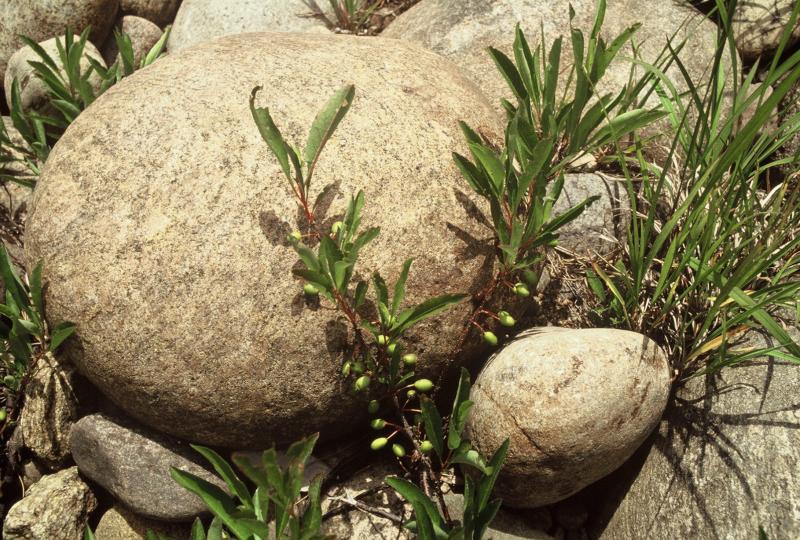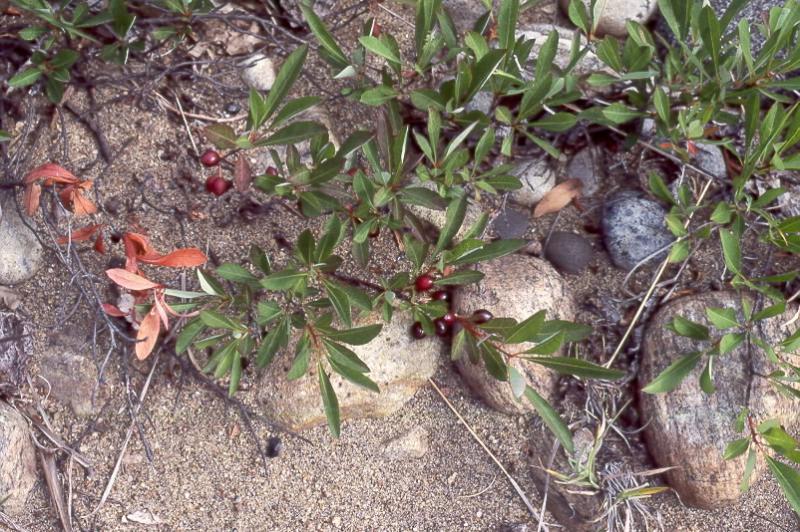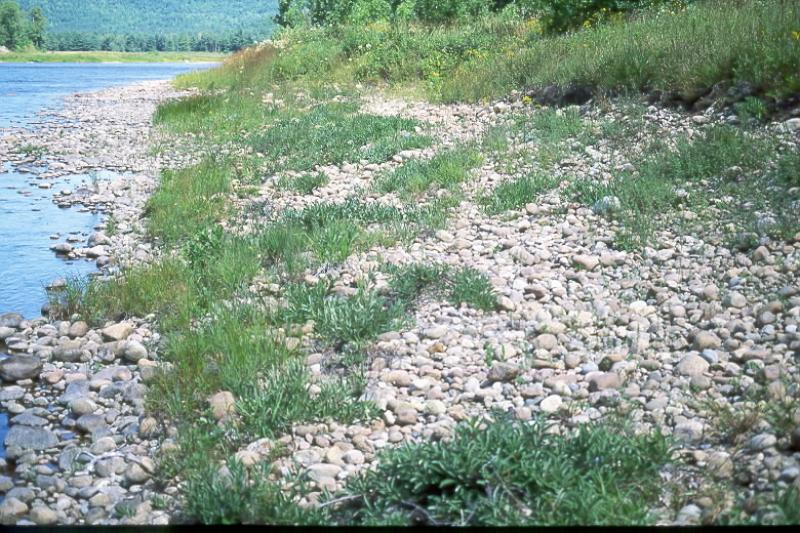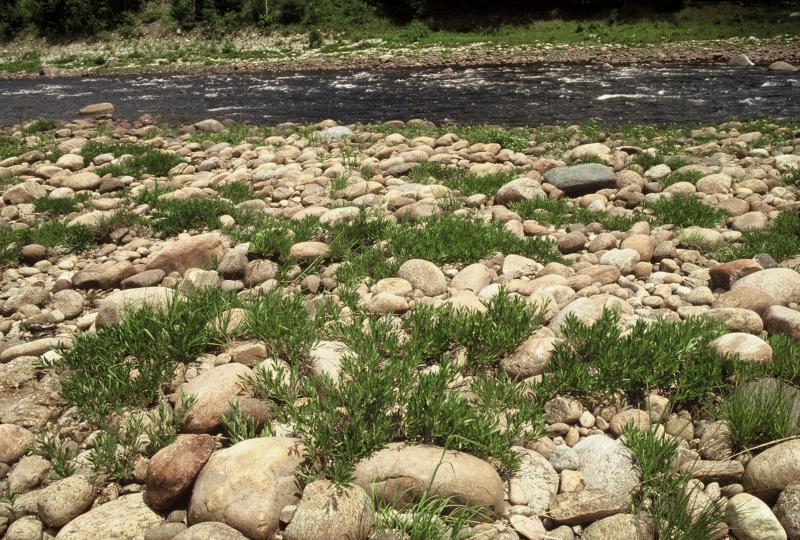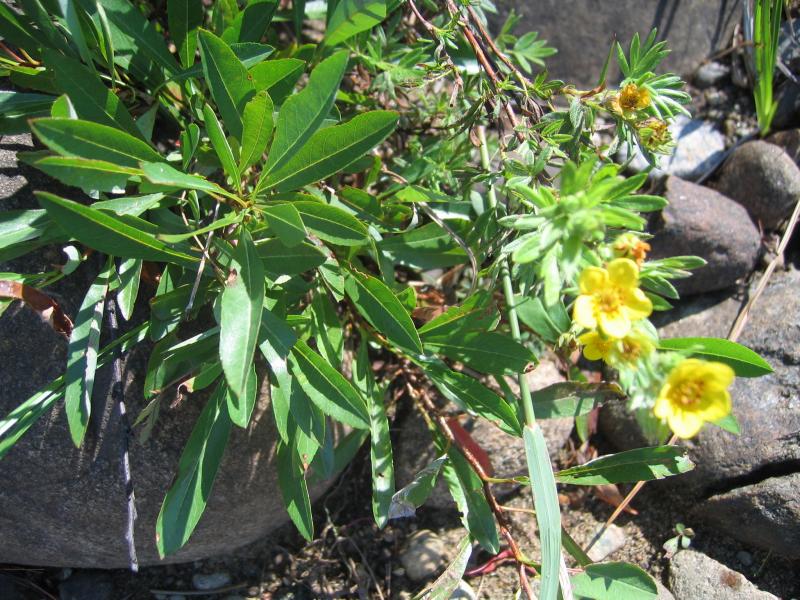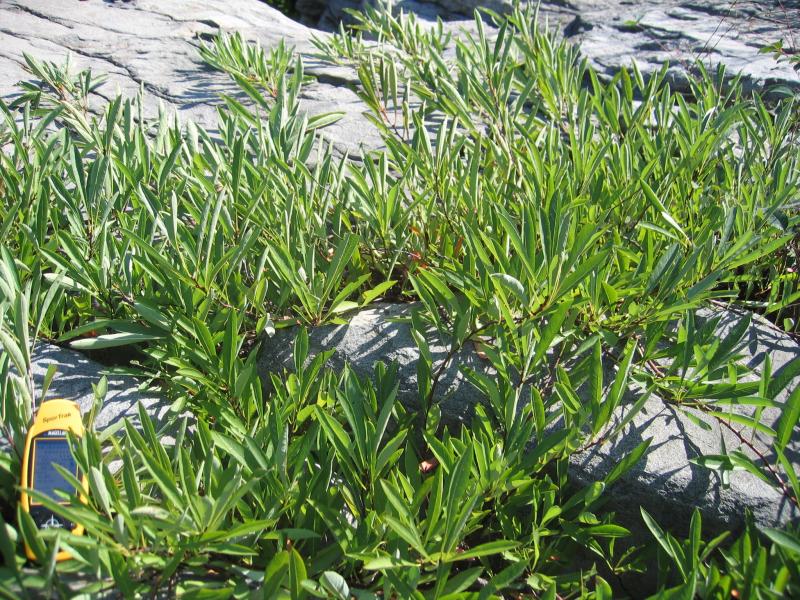Dwarf Cherry
Prunus pumila var. depressa (Pursh) Gleason
- Class
- Dicotyledoneae (Dicots)
- Family
- Rosaceae (Rose Family)
- State Protection
- Threatened
Listed as Threatened by New York State: likely to become Endangered in the foreseeable future. For animals, taking, importation, transportation, or possession is prohibited, except under license or permit. For plants, removal or damage without the consent of the landowner is prohibited.
- Federal Protection
- Not Listed
- State Conservation Status Rank
- S2
Imperiled in New York - Very vulnerable to disappearing from New York due to rarity or other factors; typically 6 to 20 populations or locations in New York, very few individuals, very restricted range, few remaining acres (or miles of stream), and/or steep declines.
- Global Conservation Status Rank
- G5T5
Secure globally - Both the species as a whole and the subspecies/variety are common in the world; widespread and abundant (but may be rare in some parts of its range).
Summary
Did you know?
In New York dwarf sand cherry is most often found on the islands and banks of large rivers, where scouring ice prevents trees and large shrubs from persisting. The prostrate, ground-hugging stems of this subspecies appear well adapted to these unique habitats. The fruit is the largest of all the native cherry species in New York and is edible but tart.
State Ranking Justification
There are 14 known populations and half of these are large containing hundreds of plants. There are about five additional historical records which need to be checked.
Short-term Trends
Many new populations have been documented in the last 20 years. All of the monitored extant populations of this plant appear to be persisting.
Long-term Trends
More research into the historical record is needed to determine the long-term population trend of this species in New York. Dwarf sand cherry forms spreading clones and is well-adapted to disturbance, so individual populations may be very long-lived.
Conservation and Management
Threats
Dams or other changes to the hydrologic and disturbance regimes of this plant's habitats are likely the greatest potential threat to this plant. Deer herbivory is another potential threat. Invasive non-native plants such as Lythrum salicaria and Euphorbia cyparissias are spreading into Prunus pumila habitat.
Conservation Strategies and Management Practices
No current management needs are apparent. Known populations should be monitored.
Research Needs
Ecological studies are needed to better understand this species' dynamic habitats. Research and surveys of historical occurences are also needed to determine if this species might be more common in limestone lakeside habitats.
Habitat
Habitat
In New York all known occurences of this species are on lake or river islands and shorelines, most often at sites with high-energy flooding, deposition, or ice-scouring disturbance regimes that inhibit soil development. Mixed deposits of sand and coarse gravel form the substrate, and dwarf sand cherry often is found growing in habitats with little other vegetation. On islands in large, fast-flowing rivers these site are often prairie-like habitats with tall grasses such as Panicum virgatum, Andropogon gerardii, and Sorghastrum nutans as dominants. (New York Natural Heritage Program 2007). Gravelly or sandy beaches and shores,especially in calcareous regions (Gleason and Cronquist 1991). Gravelly or sandy beaches in calcareous or basic soils or on calcareous pavement or slopes (Fernald 1970).
Associated Ecological Communities
- Calcareous shoreline outcrop
(guide)
A community that occurs along the shores of lakes and streams on outcrops of calcareous rocks such as limestone and dolomite. The vegetation is sparse; most plants are rooted in rock crevices.
- Cobble shore
(guide)
A community that occurs on the well-drained cobble shores of lakes and streams. These shores are usually associated with high-energy waters (such as high-gradient streams), and they are likely to be scoured by floods or winter ice floes.
- Cobble shore wet meadow*
(guide)
A community that occurs on the cobble shores of lakes and streams where the substrate is moist from seepage or intermittent flooding. These communities are likely to be scoured by floods or winter ice floes, but there is apparently no significant accumulation of pack ice.
- Riverside ice meadow
(guide)
A meadow community that occurs on gently sloping cobble shores and rock outcrops along large rivers in areas where winter ice floes are pushed up onto the shore, forming an ice pack that remains until late spring. The ice scours the meadow, cutting back woody plants.
- Riverside sand/gravel bar
(guide)
A meadow community that occurs on sand and gravel bars deposited within, or adjacent to, a river channel. The community may be very sparsely vegetated, depending on the rates of deposition and erosion of the sand or gravel.
* probable association but not confirmed.
Associated Species
- Andropogon gerardii
- Campanula rotundifolia (hare-bell)
- Deschampsia cespitosa (tufted hair grass)
- Doellingeria umbellata
- Helianthemum bicknellii
- Panicum spp.
- Symphyotrichum lateriflorum (calico-aster)
- Thuja occidentalis (northern white cedar, arbor vitae)
Range
New York State Distribution
In New York dwarf sand cherry occurs in the Adirondacks and along Lake Champlain in the north, and along the Delaware River in the southern part of the state.
Global Distribution
This plant is native in New Brunswick, Quebec, and New England, west to Ontario, Michigan, and Wisconsin, and as far south as Tennessee.
Identification Comments
General Description
Dwarf sand cherry is a colonial shrub which produces creeping stems radiating outward from the original plant. The prostrate branches seldom produce growth over 30-40 cm high, but the stems may be 3 -5 meters long, and they root prolifically where they contact the ground. The simple leaves are long and narrow, 4 to 10 cm long, finely toothed, and glaucous (whitish) on the undersides. The creamy white to pinkish flowers, with petals only 4-8 mm long, are arranged in clusters of 2 to 4. These ripen to small, blackish, edible fruit. Like that of other cherry species, the bark smells of burnt almonds if scratched.
Best Life Stage for Proper Identification
This plant may be identified in any season, though it might easily be overlooked in winter when the leaves are gone.
Similar Species
Prunus pumila var. depressa is distinctive among other Prunus species for its prostate, creeping growth form.
In vegetative form, this species may be mistaken for a willow (Salix), some species of which occupy the same habitats. If fruits and flowers are absent, it can be separated from all Salix species by its many-scaled buds, unlike willows' single-scaled buds, and by its bark, which like that other cherry species, smells like burnt almonds when scratched.
Best Time to See
Dwarf sand cherry blooms in late May or early June, and the fruits may persist through August.
- Vegetative
- Flowering
- Fruiting
The time of year you would expect to find Dwarf Cherry vegetative, flowering, and fruiting in New York.
Dwarf Cherry Images
Taxonomy
Dwarf Cherry
Prunus pumila var. depressa (Pursh) Gleason
- Kingdom Plantae
- Phylum Anthophyta
- Class Dicotyledoneae
(Dicots)
- Order Rosales
- Family Rosaceae (Rose Family)
- Order Rosales
- Class Dicotyledoneae
(Dicots)
- Phylum Anthophyta
Additional Common Names
- Sand-cherry
Synonyms
- Prunus depressa Pursh
Additional Resources
Best Identification Reference
Gleason, Henry A. and A. Cronquist. 1991. Manual of Vascular Plants of Northeastern United States and Adjacent Canada. The New York Botanical Garden, Bronx, New York. 910 pp.
Other References
Fernald, M.L. 1950. Gray's manual of botany. 8th edition. D. Van Nostrand, New York. 1632 pp.
Haines, Arthur and Thomas F. Vining. 1998. Flora of Maine. A Manual for Identification of Native and Naturalized Vascular Plants of Maine.
Holmgren, Noel. 1998. The Illustrated Companion to Gleason and Cronquist's Manual. Illustrations of the Vascular Plants of Northeastern United States and Adjacent Canada. The New York Botanical Garden, Bronx, New York.
New York Natural Heritage Program. 2010. Biotics database. New York Natural Heritage Program. New York State Department of Environmental Conservation. Albany, NY.
New York Natural Heritage Program. 2024. New York Natural Heritage Program Databases. Albany, NY.
Newcomb, Lawrence. 1977. Newcomb's Wildflower Guide: An Ingenious New Key System for Quick, Positive Field Identification of the Wildflowers, Flowering Shrubs, and Vines of Northeastern and North-Central North America. Little, Brown and Company. Boston.
Weldy, T. and D. Werier. 2010. New York flora atlas. [S.M. Landry, K.N. Campbell, and L.D. Mabe (original application development), Florida Center for Community Design and Research http://www.fccdr.usf.edu/. University of South Florida http://www.usf.edu/]. New York Flora Association http://newyork.plantatlas.usf.edu/, Albany, New York
Weldy, Troy W. and David Werier. 2005. New York Flora Atlas. [S.M. Landry, K.N. Campbell, and L.D. Mabe (original application development), Florida Center for Community Design and Research. University of South Florida]. New York Flora Association, Albany, NY. Available on the web at (http://newyork.plantatlas.usf.edu/).
Links
About This Guide
Information for this guide was last updated on: December 4, 2007
Please cite this page as:
New York Natural Heritage Program. 2024.
Online Conservation Guide for
Prunus pumila var. depressa.
Available from: https://guides.nynhp.org/dwarf-cherry/.
Accessed July 27, 2024.
